CAROLE KING - THE DIMENSION YEARS |
KINGSLEY ABBOTT TRACES THE SINGER-SONGWRITER'S ROOTS IN EARLY 60s NEW YORK |
.jpg) The release of "Tapestry" in 1971 transformed a little-known New York songwriter into a Californian soft-rock superstar. Alongside the likes of James The release of "Tapestry" in 1971 transformed a little-known New York songwriter into a Californian soft-rock superstar. Alongside the likes of James
|
|
She was ready to abandon her studies and concentrate entirely on music, but Paul Simon advised her to keep all her bases covered. A meeting at Queens College in 1958 determined King's future, once and for all. There she met Gerry Goffin, who proved to be the perfect lyricist for her music. She was dubious of her own ability with words, while Goffin considered his own early material as "lyrically interesting, but sung over inane melodies". The pair quickly established both personal and professional relationships, teamingup as songwriters and also getting married within a few months.Her activities as a demo singer won her a recording contract with ABC-Paramount at the end of 1958 - though after two of her own earliest compositions,"Goin' Wild" and "Baby Sittin' failed, flopped over the next few months.Her friend Neil Sedaka, who
had |
|
HOOKLlNES
His company was built on traditional values, like strong melodies, full song structures and memorable hooklines, and he was prepared to give a chance to any young writer who could oblige. Once again, Neil Sedaka provided the introduction, and Goffin & King were soon added to a roster that included Sedaka and his writing partner Howie Greenfield (responsible for
Aldon's first big hit, Connie Francis 's "Stupid Cupid"), Barry Mann & Cynthia Weil, and Jack Keller. Although most of his staff were originally employed as teams, Kirshner was keen for them to experiment with other combinations, so Gerry Goffin also wrote with Barry Mann and Jack Keller,and the Goffin/Keller duowere responsible for Little Eva 's wonderful |
Taylor and Joni Mitchell, Carole King was suddenly feted as a leader of the singer-songwriter movement - a position underlined by the multi-million worldwide sales of ''Tapestry''.
That album has now been remastered and reissued with bonus tracks, as part of a campaign to restore the bulk ofher 70s catalogue. But for King, "Tapestry" was merely the culmination of more than a decade of behind-the-scenes activity, during which she became one of the most important and commercially successful songwriters on the New York pop scene - and, briefly, in 1962, a genuine star in her own right. Her early progress was closely linked with a label which pioneered the girl group sound: Dimension.
Born as Carole Klein in Brooklyn, New York, in 1942, King was introduced to the piano at the age of four. She began writing songs in her early teens, and had her own group, the Co-Sines, by the time she was fourteen. Neil Sedaka was a near-neighbour, and the young Paul Simon was also growing up in the same area. Simon had already· tasted success with his Tom & Jerry recordings, like "Hey Schoolgirl", and he and Carole regularly made embryonic demos of other people'songs.
|
|
scored a major hit with "I Go Ape" on RCA, succeeded in helping Carole sign to the same label, but her sole release, "Short Mort" , left no impression on the market. Sedaka followed through himself with "Oh Carol", a chart-topping tribute to the young songwriter, but King's inevitable answer record, "Oh Neil", again failed to chart..Stalled in her career as a performer, Carole concentrated on writing songs with Gerry Goffin. In 1958, Al Nevins and Don Kirshner had set up Aldon Music, based at 1650 Broadway in Manhattan, across the road from the famous Brill Building. Their plan was to build up a songwriting stable to provide material for the white youth market. Kirshner himself was already a songwriter, with Gene Vincent's ''Wear My Ring" among his credits.
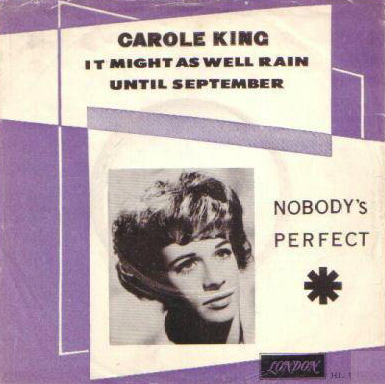
|
|
"The Trouble With Boys" and Brenda Lee 's "It Started AlI Over Again". Carole King also collaborated with Weil, Greenfield, Keller and Art Kaplan, while as a pair she and Gerry worked with Greenfield, Artie Ripp and (eventually) Phil Spector. But there was no mistaking the magic of the Goffin & King partnership. In 1960, they penned "Will You Still Love Me Tomorrow" with Johnny Mathis in mind,but it was Luther Dixon, the producer of the successful girl group, the Shirelles, who nabbed the song..He heard it at Aldon's offices, and although the Shirelles complained that it was "too country", he persisted. With Carole King playing kettle drums on the session, they eventually recorded what proved to be their
best-known and biggest hitDixon was astute enough to let King arrange the track, while he concentrated on the vocals. The Shirelles later recorded another Goffin & King tune, "What A Sweet Thing That Was".Meanwhile, Carole wrote and helped to record an answer disc to her own hit. Entitled "Not Just Tomorrow But Always", it was issued under the name of Bertell Dache -alias King and Tony Orlando - on United Artists, though it was so similar to the Shirelles original that it failed to click.
|
PARTE 2 |
|
|
|
.jpg) |
With one major hit beneath their belts, Goffin & King went into overdrive, turning out dozens of crafted pop tunes under Kirshner's direction. The American pop industry was in a lull after the initial
impact of rock'n'roll, and what was selling was safe white pop, packaged to appeal to, rather than frighten, middle America. Goffin & King unashamedly aimed at this market, and supplied hits for Bobby Vee, Tony Orlando, the Everly Brothers, the Crickets and the Drifters. Records like "Take Good Care Of My Baby", "Run To Him", "Halfway To Paradise", "Bless You", "Crying In The Rain", "Don't Ever Change", "Up On The Roof' and "When My Little Girl Is Smiling" made the Aldon team New York's hottest publishing house in1962/1963.
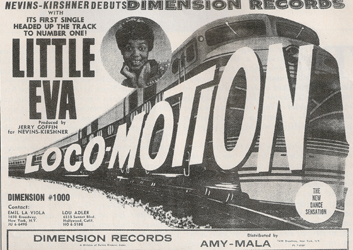
LABELS
With such a productive writing team under his command, Don Kirshner hatched a plan to have them write hits for an in-house record company. The result was not one label but two, Dimension and Companion - 'both of which were launched with singles that had heavy involvement from Carole King.
By 1962, King had two young children, Louise and Sherry, to look after, while still trying to maintain her run of success. To help her cope, she hired a live-in babysitter- cum-housekeeper, Eva Boyd, who had been working as a member of the girl group, the Cookies, cutting demos for Aldon. As legend has it, Boyd's dance movements around the house inspired Goffin & King to write "The
Loco-Motion", and she was the natural choice to sing on the demo. The song had been composed with "Mashed Potato Time" hitmaker Dee Dee Sharp in mind, but Boyd's demo - arranged and produced by King - turned out so well that Kirshner decided to release it instead. Boyd became Little Eva, and the song was a Top 10 hit on both sides of the Atlantic, establishing the Dimension sound which was virtually set in stone for the next two years. |
|
Meanwhile, Carole King became the first -and indeed only - artist on the Companion label, when the GoffinlKing- composed "It Might As Well Rain Until September" was issued around the same time. When it emerged that there already was
another Companion Records, "September" was transferred to Dimension, where it became a
Nº. 22 hit in the States, and a massive Nº. 3 in the UK. Bizarrely, that British success wasn't followed up: two further US singles by King, "School Bells Are Ringing" and "He's A Bad Boy", were rejected by London-American as being sub-standard, although not before details had been announced to the weekly pop press. It is possible that there might be UK demos of either or both singles in existence, but none has ever been documented.
Dimension never matched this early flurry of success, but the label survived until 1965, by which time the hits had long since dried up - leaving behind a legacy of 51 singles and two LPs (one by Little Eva, the other the "Dimensión Dolls" compilation). Goffin & King's close involvement in the label's early history is highlighted by the fact that they either wrote and produced 19 of the first 22 releases. But by 1963 their attention had switched elsewhere, and they only had a hand in three of the later Dimension singles.
As Little Eva's debut hit suggested, Dimension rode the girl group sound for all they were worth. Eva had eight releases, the Cookies another five (among them the Goffin/ King song "Chains", covered by the Beatles), and even the reluctant King had three. Other girl group-styled issues featured Eva's sister Idalia Boyd, the wonderful Cinderellas, the Jewels, and even an early outing by the Ronettes. There were also several singles by Big Dee Irwin, whose records are often granted honorary girl group status by collectors because of the involvement of Little Eva and the Cookies. The non-Goffin & King releases on Dimension were a mixed bunch.
.jpg)
|
|
Besides the girl group singles, there were also 45s by the Shut Downs, the Cabin Crew and the Snowmen closer to the surf and hot rod sound. There was even a Beatles cash-in from Crickets guitarist Sonny Curtis. But in 1964 the label changed hands, when Aldon was sold, and thereafter Dimension became little more than a ragbag of oddities from the Colpix catalogue (the label which handled Dimension product in the UK, incidentally, from this point on)
STYLE CHANGE
Meanwhile, Carole King's writing style was changing, as Lou Adler, who ran the West Coast office of the newly incorporated Screen-Gems/Aldon empire, noticed: "I'd heard many ofher demos, which were always circulating among producers and A&R men. No one gave them back, because they liked Carole's vocals and piano feel so mucho Her voice was raw, yet soulful, and her piano style combined R&B and pop in a way that was very important. And she did all the background vocals on her demos. She had a lot of things going that the public hadn't heard yet."
There were still some out-and-out pop hits to come from Goffin & King, like "I'm Into Something Good", which started out as a solo release for Cookies singer Earl-Jean. But Adler had noted the more soulful influence that was creeping into King's sound, and which was evident on records like "One Fine Day" (a hit for the Chiffons) and "Hey Girl" (Freddie Scott).
This uptown soul sound became their chief direction through the mid-60s, as they penned hits for Jay & the Americans ("Some Kinda Wonderful"), Betty Everett ("I Can't Hear You No More"), the Honey Bees and Dusty Springfield ("Some Of Your Loving ") and Maxine Brown (the sublime "Oh No, Not My Baby"). There was also the wonderful "Natural Woman" for Aretha Franklin, the song which more than any other pointed the way for Carole's eventual direction as a solo artist.
Despite their success as a duo, Goffin and King were still sometimes collaborating with other partners, notably Gerry's work with Russ Titelman. This combination produced superb, sexy songs like the Cookies' "I Never Dreamed", and "What Am I Gonna Do With You, Hey Baby", which was cut by the Chiffons, Lesley Gore and the Inspirations.
|
During this period, Phil Spector had regularly plundered Aldon's catalogue for early Crystals singles like “Uptown", "What A Nice Way To Turn Seventeen", "Please Hurt Me" and "He Hit Me (And It Felt Like A Kiss)".With Spector's star still in the ascendancy, as Dimension's was fading, it was perhaps inevitable that there would eventually be a writing collaboration between Goffin & King and the maverick producer. He had already recorded their song, "Every Breath I Take", with Gene Pitney, and worked with other established composing teams like Mann & Weil and Greenwich & Barry. The Goffin/King/Spector liaison began with "No One Ever Tells You" for the Crystals, but didn't develop as prolifically as those other teams. But the trio did manage "Just Once In My Life" and "Hung On You" for the Righteous Brothers, and "Is This What I Get For Loving You Baby" for the Ronettes. In addition, Spector grabbed Goffin & King's "A Long Way To Be Happy" for Darlene Love.
STRINGS
There were other strings to Goffin & King's bow, like the ron of easy listening pop hits which included "Go Away Little Girl" and "Walkíng Proud" for Steve Lawrence, "Everybody Go Home" for Eydie Gorme, Steve &Eydie's worldwide smash "I Want To Stay Here", and Skeeter Davis 's "I Can't Stay Mad At You".
.jpg)
|
|
Pure pop returned in 1964, when they provided a hit for the Tokens (US) and the Rockin' Berries (UK) with "He's In Town", and Herman's Hermits with "Show Me Girl". But by 1965, the music business was changing, with the emphasis shifting towards groups and soloists who penned their own material. Among them were Lennon & McCartney, who admitted later that "all we ever wanted to be was Goffin & King".
Meanwhile, the pair were facing increasing competition at Screen-Gems/Aldon, with the recruitment of writers like David Gates, Tommy Boyce and Bobby Hart. Goffin & King continued to supply superior material for bands like the Monkees ("Pleasant Valley Sunday", "Porpoise Song") and the Byrds (''Wasn't Born To Follow", "Goin' Back"), but they also began to plan for an alternative
future. The result was Tomorrow
records, who signed up a band called the Myddle Class, featuring bassist Charles Larkey (who ironically became King's second husband after she and Goffin divorced in 1968). Another Tomorrow artist was none other than Carole King, whose marvellous 1967 single "Road To Nowhere" (which was a belated UK follow-up to her 1962 hit) perhaps reflected her decaying relationship with Goffin.
The song represented the end of one era, and the dawn of another. In 1968, King and Larkey formed the City, whose solitary album (issued on Lou Adler's label, Ode), "Now That Everything's Been Said", looked forward to her success as a soloist with "Writer" and most significantly, "Tapestry". But even as she became a leading light of the singer- songwriter generation, Carole King often revisited the hits she and Gerry Goffin had written a decade earlier. Given their quality, it is hardly surprising that those songs are still fondly remembered today.
|
|
Grace of my Heart
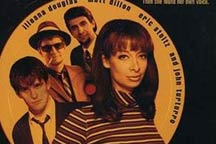
The 1996 movie Grace Of My Heart was loosely based around the early career of Carole King. It features characters drawn on Phil Spector, Gerry Goffin and Little Eva (though she knew nothing about the movie when I spoke to her), and the central character starts out as an obvious take on King. But the movie soon slips away from historical accuracy, with the Carole character metamorphising into something closer to Marilyn Wilson, ex-wife of Beach Boy Brian Wilson. It's a hotchpotch of a film, but still watchable for those intrigued by this period of pop history. The soundtrack album not only has the first collabora-tion between Burt Bacharach and Elvis Costello, but also a nice 60s girlie soundalike called "I Do", performed by For Real in flouncy girl group dresses!
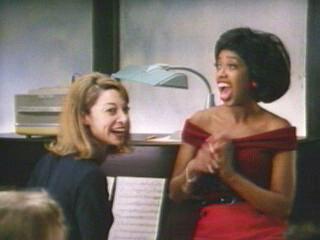
|
PARTE 4 - LITTLE EVA - INTERVIEW |
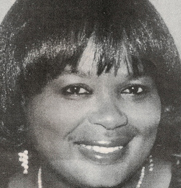
Last autumn, a 60s-style package show arrived on these shores for a 27-date tour around major cities. Indeed, the line-up could have come straight from 1962, as the All American Solid Gold Rock'n'Roll Show featured Bobby Vee, Chris Montez, Johnny Preston, Brian Hyland - and Little Eva.
She sang four songs, "The Loco-Motíon", "Keep Your Hands Off My Baby", "Let's Turkey Trot" and "Twistin' The Night Away", and had the entire audience on their feet for a mass display of the Loco-Motion.
Though her current repertoire suggests that her career ended when she left Dimension in the míd- 60s, Little Eva did go on to record singles for Amy ("Stand By Me"), Verve ("Bend It", a cover of the Dave Dee hit, and "Take A Step In My Direction"),
and Spring ("Night After Night" and a medley of two Motown smashes, "Get Ready" and "Uptight"). In 1989, she returned after a long absencefrom the recording scene with an album on Malibu, "Rack On Track".
But it's her role in the Dimension story, and her debut hit "The Loco-Motion", for which Little Eva will always be remembered. RC spoke to her a couple of weeks after that UK tour, when she was back home in North Carolina
Q: How did you come to work with Goffín & King in the first place?
A: I had been hired for the Cookies, so I was already doing some work with Carole and Gerry. They needed some help at home, so they asked me to become a housekeeper and cook, but mainly to be a babysitter. They did like my cooking, though! I got $35 a week. Later on, my sister Idalia became a spare babysitter when I got real busy with music. She had a release with "HuIa Hoppin' " on Dimension. |
|
Can you remember much about your early sessions with the Cookies?
I sang on "Gloria Gloria" and "Don't Play That Song" for Ben E. King, and I'm on the Cookies' "Don't Say Nothin' Bad 'Bout My Baby". Yeah, and I think that my version of "D p On The Roof' was the original demo. "Loco-Motion" was a demo for Dee Dee Sharp to tie in with her dance records, but it came out so well that we kept it!
Did you also demo "One Fine Day'!?
Yes, that's one I do remember, I think!
What were those sessions like?
Well, on "Loco-Motion" there are four voices, that's me and Carole doubled up. Carole and Gerry very much called the shots. They were in charge of everything.
My problem was that "Loco-Motion" was such a big hit that it was impossible to top. I got typecast as a sort of a novelty act. The Cookies were more grown-up, and I wanted to do more of that kind of stuff. Of my stuff, I really like "Down Home" and ''Where Do I Go". Basically, I suppose I was happy with my songs, apart from "Old Smokey Locomotion", which I didn't care for at all.
Who was the best producer you ever worked with?
After Dimension, there were people who tried, but they didn't get anywhere. I have talked again since to Gerry. He seemed to be a bit more interested in recording me, but nothing happened. I'd still like to do more things. I can sing grown-up now!
Have you spoken at all to Carole recently?
I've called her a couple of times, but she's never there. She's always touring.
Finally, what do you think of the music scene of today?
I am really not happy about the whole rap scene. I see it as a craze like all the others, and I'll be glad when it is over. I don't like the clothes and what they stand for. There are a lot of bad influences within rap music. It's all putting the wrong sorts of pressures on modern children. |
| CAROLE KING PRE-DIMENSION SINGLES |
ASC Paramount 9921 GOIN' WILD I THE RIGHT GIRL (1958)
ASC Paramount 9986 BABY SITTIN' I UNDER THE STARS (1959)
RCA 7560 SHORT MORT I QUE EN OF THE BEACH (1959)
Alpine 57 OH NEILJ A VERY SPECIAL BOY (1959)
Companion 2000 IT MIGHT AS WELL RAIN UNTIL SEPTEMBER I NOBODY'S PERFECT (1962) |
DIMENSION RECORDS LABEL LISTING PART 1 |
DIMENSION RECORDS LABEL LISTING PART 2 |
|
 |
NOW AND FOREVER - HOMENAJE A CAROLE KING |
@ 2005/ 2010FAN DE CAROLE KING |
|